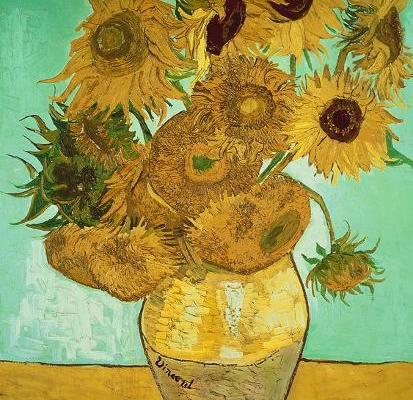|
By Elifsu Gencer
If one were asked to list some of post-impressionist painter Vincent Van Gogh’s most famous pieces of artwork, the still life Sunflowersseries is surely among the first to come to mind. While living in France during the 1880’s, Van Gogh painted his first set of sunflowers, depicted lying across a tabletop, and later, his second, more well-known bouquet of sunflowers propped up in a vase. These works are known for their stunning yellow hues, aptly referred to as “Van Gogh Yellow,” which Van Gogh began to use more frequently in his paintings during the latter half of his career. While the exact reason for this interesting artistic flair remains a mystery, there has been much speculation about Van Gogh’s affinity for the color yellow. Some of these claims include a medical condition known as xanthopsia, or yellow vision, caused by glaucoma; thujone poisoning from absinthe consumption that skewed his perception of colors; or effects of the prescription drug digitalis (more commonly known as foxglove) that he was taking to treat his temporal lobe epilepsy. Whatever the reason may be, however, a tragic reality has recently emerged that surely would have deeply saddened Van Gogh: though not visible to the naked eye just yet, the once-vibrant yellow pigment that Van Gogh cherished so much has begun to fade to a dull brown. A team of researchers from the University of Naples Federico II has undertaken the mission of investigating this unexpected phenomenon in these paintings by studying Van Gogh Yellow, formally known as a family of lead chromate pigments that are often mixed with lead sulfate to create different yellow shades. While the “browning” observed in the Sunflowersseries was revealed to be due to pigment degradation, a closer spectroscopic analysis of these affected areas demonstrated high sulfur contents. This finding has in turn led Muñoz-Garcia’s team to determine the particular mechanism underlying pigment degradation, which remarkably stems from the pigment’s own composition. Specifically, the composition of chromates and sulfates has made Van Gogh Yellow unstable and has possibly resulted in the separation of the compounds. The separated clusters of sulfates are thought to absorb UV light, providing sufficient energy for the reduction of the chromate ions into chromic oxide, a compound green in color that contributes to the browning effect seen in the dulling yellow sunflowers. Unfortunately, because the pigment composition itself is unstable, the color degradation in the Sunflowersseries is currently not preventable. A recent study by Frederik Vanmeert of the University of Antwerp in 2018 also examined the composition of Van Gogh Yellow using macroscopic x-ray powder diffraction imaging, a new non-invasive method that can reveal specific chemical distributions at the macroscale. Their analysis, in line with Muñoz-Garcia’s findings, supported the observation that areas rich in the mixture of chromate and sulfate were prone to the darkening of the yellow pigments. Although Vanmeert agreed that the pigment degradation cannot be prevented at this point in time, he suggested that the process could be slowed by establishing optimal lighting conditions with minimal to no UV light. However, while UV light is known to be damaging to many forms of art, ensuring its elimination from museums can prove to be especially difficult because it cannot be detected by the human eye. In addition, natural UV light emission during the daytime makes it challenging to determine just the right amount of light that would allow visitors to enjoy the artwork on display without simultaneously damaging it. With that said, curators at the Van Gogh Museum have already chosen to lower the lighting of the museum and further review the lighting conditions of artwork displays. Although determining the optimal conditions is a painstaking task with countless variables to consider, it is necessary to preserve not only the iconic Sunflowersseries, but also other paintings and forms of art, such as artifacts. Studies conducted by the Muñoz-Garcia and Vanmeert groups and the subsequent development of non-invasive imaging techniques provide strong scientific foundations for optimizing conservation strategies which are also applicable to the study of other artworks.
0 Comments
Leave a Reply. |
Categories
All
Archives
April 2024
|

